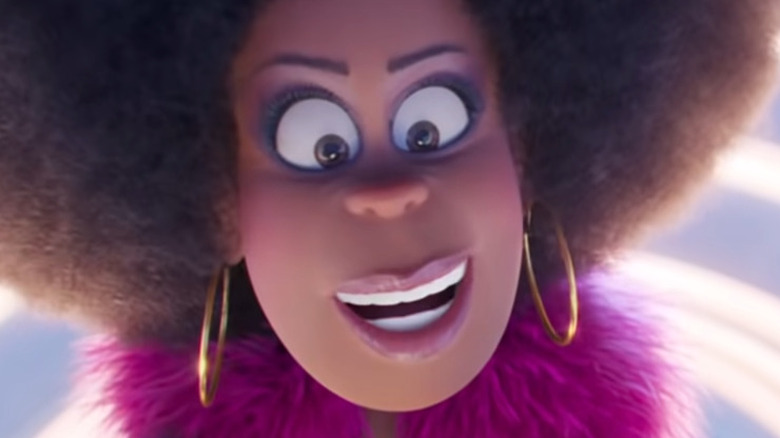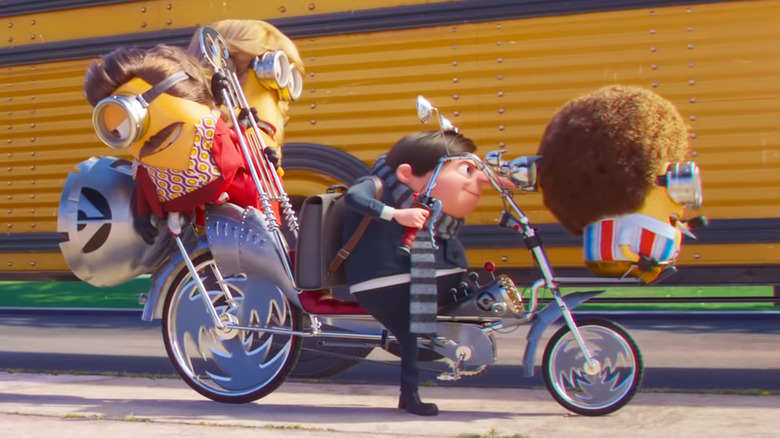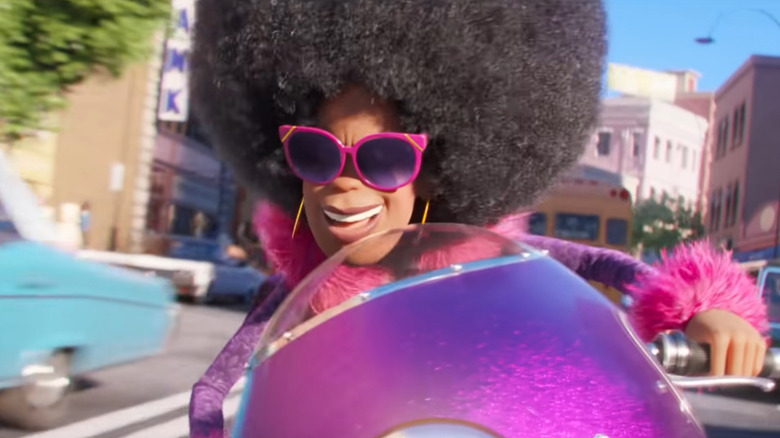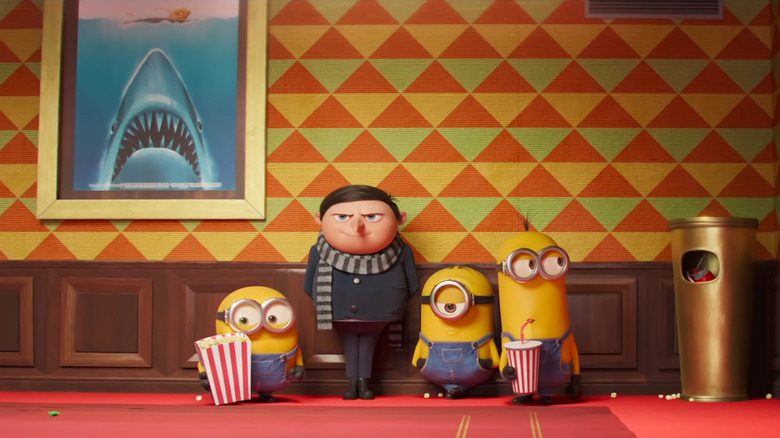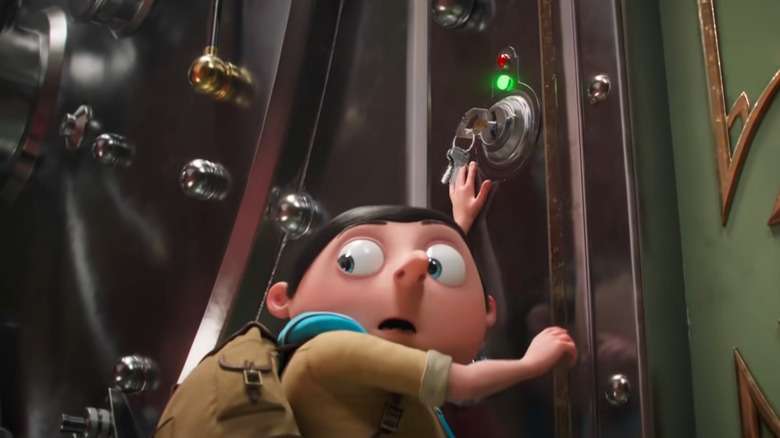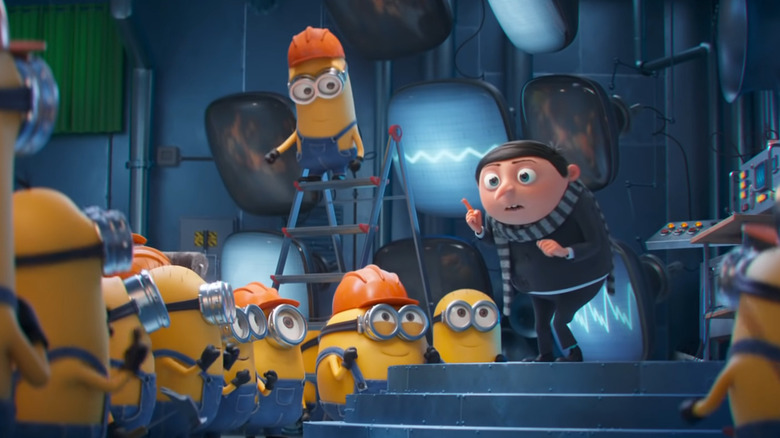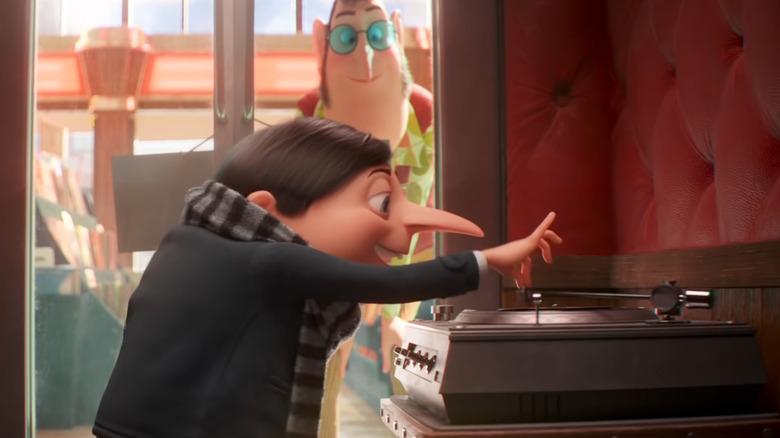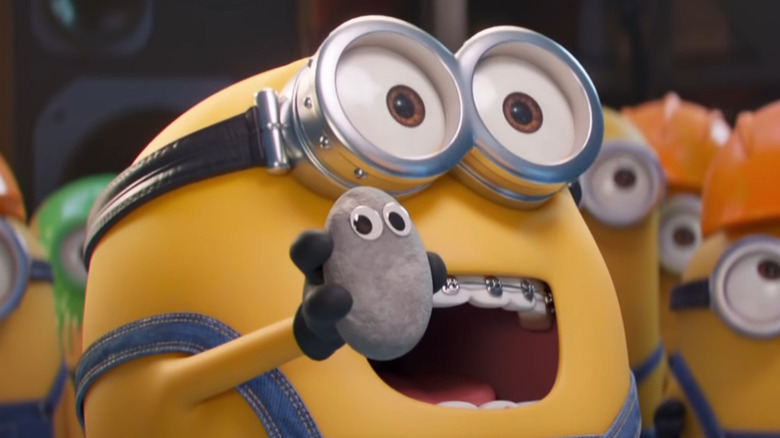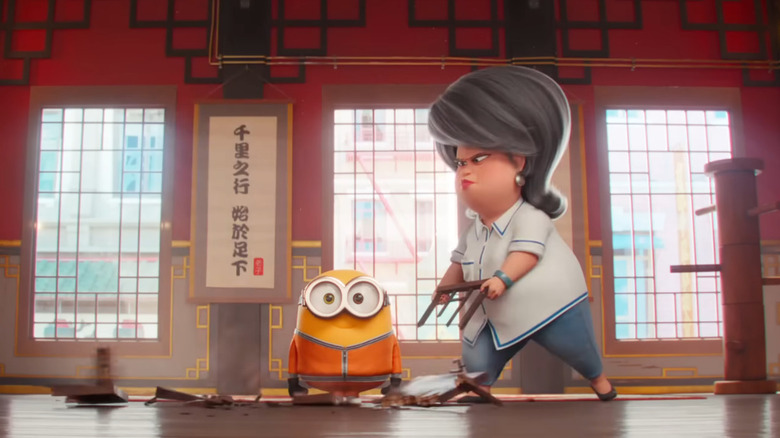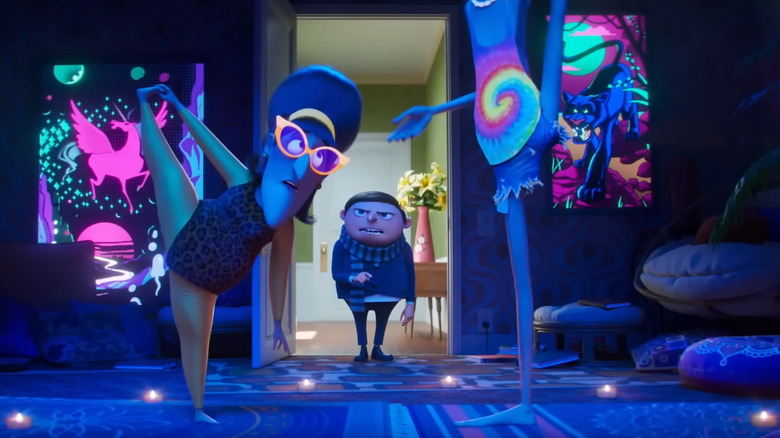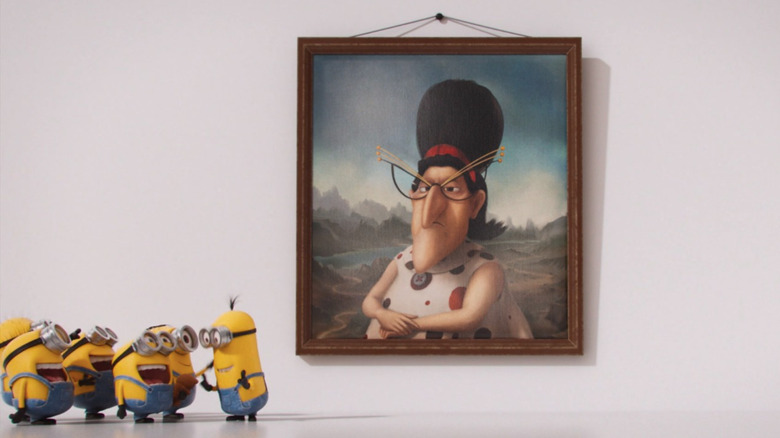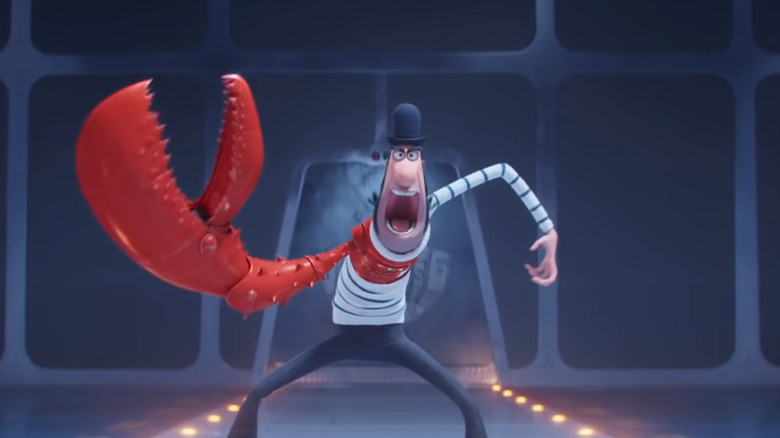Things Only Adults Notice In Minions: The Rise Of Gru
There's just something universally appealing about the Minions. At the time of this writing, the three "Despicable Me" films and the two "Minions" spin-off movies have collectively made over $4 billion at the global box office. It's difficult to achieve this level of success if the material doesn't appeal to a wide range of people. To this point, the little yellow guys have connected with viewers of all ages, from the expected younger fans to some decidedly unexpected demographics like teenagers in formal wear and retirees sharing Facebook memes.
2022's "Minions: The Rise of Gru," the fifth entry in the overall franchise, sees a young version of Steve Carell's Gru aspiring to be a supervillain in the 1970s. While auditioning to join a nefarious group of bad guys called the Vicious 6, Gru is kidnapped by one of the group's former members, Wild Knuckles (Alan Arkin). From there, it's off to the races as the Minions embark on a quest to rescue their beloved "mini-boss" (their nickname for Gru).
Illumination, the animation studio that creates the series, certainly develops their work with a family audience in mind, but they make sure adults can enjoy their time at the movies just as easily as kids. Through that lens, let's take a look at some things only adults notice in "Minions: The Rise of Gru."
The bicentennial
The wardrobe, soundtrack, and other quirks throughout "Minions: The Rise of Gru" make it clear that the film takes place sometime during the 1970s. The story also prominently features Lunar New Year, which happens in January or February depending on the year, as a major plot point. Those who look closely in the background will be able to discern specifically what year the movie is set in.
During an action sequence taking place within the city streets early on in the film, a billboard behind Gru advertises the bicentennial — the 200th anniversary celebration of the United States, which happened in 1976. Adults old enough to remember the bicentennial festivities may recall how big of a deal the nation made of its birthday that year, with celebrations extending the length of 1976, not just in July.
This quick piece of signage firmly places "Minions: The Rise of Gru" within winter 1976, though children unfamiliar with the term "bicentennial" might not know the historical context enough to connect the dots from the billboard to the year. Since it's not a commonly used word today, it might go over kids' heads (and it's also possible that "bicentennial" is simply too big a word for some viewers to comprehend on their reading level. All they need to know is: "Young Gru = a long time ago."
The rotary phone
Winding back the clock to showcase a younger version of Gru as the protagonist of this second "Minions" film means the story takes place in the 1970s. As such, filmmakers lean into the many opportunities this offers to infuse signature pop culture from the decade into the movie. One instance is a gag involving a rotary telephone.
A villain named Wild Knuckles kidnaps Gru and makes a ransom call to the Minions. Holding his rotary phone, Wild Knuckles commands Gru to dial the number needed to reach them. In comparison to the smartphones of the 21st century, a rotary phone is altogether archaic — if not completely foreign — to children in the audience. Rather than quickly tapping numbers on a screen, Gru must select each number in the sequence individually and wind the digit's slot all the way around the phone's surface before selecting the next number.
Animators leverage the comedy of the moment by completely pausing the action of the otherwise tense scene to show Gru dialing the entire phone number. It's comically slow by today's standards and even funnier in the context of the story.
The needle drops
Since the movie takes place in the '70s, the soundtrack of "Minions: The Rise of Gru" employs numerous period-specific songs that adults might recognize more than kids. Some of these tunes appear in their original format, with the vocal performance featured in the movie being the same that music listeners in the 1970s would have heard. These include "Shining Star" by Brittany Howard and Verdine White, as well as "Fly Like An Eagle" by Thundercat. Other times, "The Rise of Gru" lets modern artists cover classic '70s songs, like St. Vincent performing "Funkytown," which was initially made famous by Lipps, Inc.
The movie's soundtrack also occasionally features an original song recorded in the style of some of those '70s disco classics. "Turn Up the Sunshine" by Diana Ross and Tame Impala, for instance, was specially made in 2022 just for this movie, but is meant to sound like it's from days gone by. Younger viewers in the audience probably won't be able to tell the difference between which songs are authentically retro, modern covers, or new songs altogether, if they even realize the throwback motif at all, which also extends to the '70s flair of the production design and wardrobe.
Gru interrupts a Jaws screening
One scene in "Minions: The Rise of Gru" involves Gru throwing a fart bomb into a movie theater, effectively clearing out the auditorium so he can enjoy a private screening (donned in a gas mask, of course). Illumination animators leveraged this opportunity within the movie's '70s aesthetic to pay tribute to the first summer blockbuster, Steven Spielberg's "Jaws."
"Jaws" hit cineplexes in 1975 and is today considered the first in its own genre of movies: A special effects-driven spectacle released in the summertime and designed to draw large crowds. Before "Jaws," summer was a notoriously lousy time to release movies (thanks in part to the lack of air conditioning in most theaters). But "Jaws" turned the tide, and the summer blockbuster calendar is now an annual lineup of action-packed events.
There's one small hiccup with this otherwise sublime throwback. "Jaws" was a summer blockbuster, and "The Rise of Gru" firmly establishes its timestamp as during Lunar New Year, which takes place during the winter. While "Jaws" was very successful, it's a stretch to imagine it was still packing out theaters that long after its summertime release. Regardless, people who were old enough to see "Jaws" in 1975 may be reminded of the nostalgia from that era by seeing a room packed with moviegoers experiencing the drama of the film for the first time in "The Rise of Gru."
Gru steals a fake Mona Lisa
In "Minions: The Rise of Gru," a villain named Wild Knuckles kidnaps Gru and holds him ransom in San Francisco. While biding his time until the Vicious 6 and/or the Minions arrive to rescue Gru, Wild Knuckles takes advantage of the opportunity to show the aspiring supervillain some tricks of the trade. This includes a visit to the Bank of Evil, where Wild Knuckles plans to fake a medical emergency so Gru can sneak into the vaults and steal money.
Their heist is successful, and on the ride home Gru reveals he stole something else for good measure: The Mona Lisa. The pair celebrates the victory, but they might want to verify their goods first. In real life, the Mona Lisa is on display in France at the Louvre Museum, where it's been since the beginning of the 19th century, with the exception of occasional travel exhibitions, according to Britannica. While the painting was in the United States in the '60s and its most recent trip was to Tokyo in 1974, it wasn't in San Francisco in 1976, when the movie takes place, which means Gru likely has a fake on his hands. This is hardly something to gripe about in a film about talking yellow creatures wearing goggles, though, and the quick gag serves its purpose: It shows Gru going the extra mile to get something done.
Is the math right on young Gru's age?
In contrast to the "Despicable Me" films, which take place in present day, the "Minions" prequels thus far have wound back the clock and have taken place in their own distinct decades. This not only works out narratively within the timeline of the franchise, but allows filmmakers to thread the production design with fun throwback stylings. However, there might be a discrepancy — or at least an unimportant suspension of disbelief — in the difference between Gru's age in the two "Minions" movies.
Young Gru appears briefly at the end of 2015's "Minions," which is set in 1968. In 2022's "Minions: The Rise of Gru," the year is 1976 and Gru is almost 12 years old. If eight years have really elapsed between the films, Gru is three years old in "Minions," which doesn't quite make sense. For starters, there is very little difference in the character design from the 2015 to 2022 models. Additionally, the 2015 appearance sees Gru out on his own without adult supervision — and capable of flying a mini-jet.
This isn't a huge deal, and probably goes unnoticed by most moviegoers. Less crucial than the exact math behind the "Despicable Me" canon is the fun of seeing a younger version of Gru have his chance to shine.
Playing the record backward
In "Minions: The Rise of Gru," the titular character is invited to audition for a spot in the supervillain group known at the Vicious 6. Gru's recruitment begins in a secret booth at a record store. Firstly, this setting is likely foreign to most younger viewers, who are more accustomed to listening to music digitally via their phones and other devices. The bit continues to introduce kids to technology of the stone ages via the instructions the Vicious 6 leave for Gru.
In order to access their lair, Gru has to play a record backward. Reversing the direction of a vinyl is simple enough, but most of the time it just leads to indecipherable noise, as the track was intended to play in the other direction. Here, though, Gru discovers a secret message. This is a joke in itself, one that will definitely go over the heads of youngsters in the audience.
There was a time when bands and artists would hide messages on recordings by intending them to be played backward. It led to conspiracy theories involving the Beatles and a bunch of other groups from the 1970s and '80s. "Bands like Led Zeppelin, Judas Priest and even The Eagles were accused of spreading satanic messages subliminally," according to the BBC.
Pet rocks were a real thing
At a birthday party in the film, a kid receives a pet rock as a gift. It's nothing fancy, just a regular rock with two googly eyes attached. Because the jokes are generally very wacky in "Minions" movies, children in the audience might think the gag is simply part of the silly situations that usually follow these characters. Adults, on the other hand, may remember the pet rock fad that swept the nation in 1975, making it perfectly topical for a movie taking place in 1976. Mental Floss notes that entrepreneur Gary Dahl made $1 million from pet rocks at the height of the phenomenon's popularity.
Unfortunately, Otto the Minion just can't help himself when he sees an opportunity to get in on the pet rock craze. He's walking past the party as the birthday kid gets gifted their rock, and Otto forgets all about his mission to deliver a mystic amulet to Gru, swiftly trading the amulet for the pet rock. Poor Otto spends the length of the film correcting his mistake. Cinephiles keeping score will note that this incident makes "Minions: The Rise of Gru" part of a strange coincidence: Two films featuring Michelle Yeoh and a rock with googly eyes dropped in 2022, the other being "Everything Everywhere All at Once."
The kung fu scene is inspired by several films
Three of Gru's most loyal Minions — Kevin, Stuart, and Bob — set out to rescue their "mini boss" when Wild Knuckles kidnaps Gru and takes him to San Francisco. To help them stand a better chance at winning against Wild Knuckles in combat, the Minion trio pursue training in the art of kung fu from an expert named Master Chow. The sequences involving Master Chow's training visually switch gears from the film's typical aesthetic. Sleek, high-definition animation gives way to sequences designed to emulate technical limitations from cinema of yore, like large, bold lettering — that shakes ever so slightly — to introduce the premise of the scene. Adults will be more aware of what these sequences thematically pay tribute to than children.
Speaking to Variety, director Kyle Balda revealed which movies influenced this scene and the film's action as a whole. "Jackie Chan across the board because his films have such a great blend of really high stakes action and comedy. It's sort of a big influence for the Minions," Balda told the Hollywood trade. "And Jackie Chan is just brilliant at bringing the acting and the comedy into the action. One of the clearest winks [to kung fu films] I would say, is more to Stephen Chow and things like 'Shaolin Soccer' and 'Kung Fu Hustle,' which you can really see with Master Chow. Her character is really grounded in that kind of comedy. There's also a little bit of 'Crouching Tiger, Hidden Dragon' too."
Exercise gurus were all the rage
In one memorable scene, Gru is startled to come home from school and find his mom performing exercises with a man in a tie-dye shirt and cutoff jean shorts. A spare room in the house has seemingly been transformed for this occasion, with the lights turned off in favor of candles on the floor and blacklighted items. "Mom, who is this sweaty guy?" Gru inquires. "He's stinking up the house! I thought you were cooking cabbage."
Gru's mom informs her son that this is her "guru," and goes on to say that the Minions are ruining her "mellow vibe." Kids aren't likely to know this, but (according to Harvard University's Pluralism Project) gurus were extremely popular in 1970s America, when "The Rise of Gru" takes place. The word "guru" means "spiritual teacher," and some gurus in the '70s were connected to an increase in Hinduism in the West. Other gurus brought physical habits like yoga or meditation without any spiritual component, as seems to be the case with Gru's mom.
Gru's mom is clueless
One thing that adults will no doubt notice is that Gru is being held hostage for the majority of this film, but his mom doesn't even seem to notice. Furthermore, when Wild Knuckles calls Gru's residence to lay out his terms, it's the Minions who answer the phone, not Gru's mom. This leaves her on the fringes of the story, and judging by the way she seems completely unbothered when shown later hosting a Tupperware party, we might assume she's completely oblivious to her son being in danger.
It's during said Tupperware party that the Vicious 6 completely destroy the home in search of Gru, and his mom is finally made aware of what's going on. Still, parents in the audience tracking the length of time Gru has been gone can point to his mom's lack of awareness as terrible parenting — which voice actor Julie Andrews is also quick to point out. The veteran called her character "the worst role model for a mother" during an appearance on "The Tonight Show Starring Jimmy Fallon.".
It's possible that Gru's extracurriculars as a wannabe villain frequently take him on overnight exploits, and his mother is perhaps used to her son being gone for long stretches of time. Even if that's true, it's clear that there's plenty of room for improvement when it comes to her parenting techniques, and parents in the audience might find her cluelessness a little hard to believe.
One villain's name is a meta joke
As an aspiring villain, Gru looks up to the Vicious 6 as his idols. He wants to be the world's greatest supervillain, and the Vicious 6 are as villainous as they come. The group is made up of several memorable personalities, each with their own bad-guy name. Some of them even have a theme/gimmick going on. Such is the case for Jean-Clawed, a member of the Vicious 6 who has a giant lobster claw for a hand.
While some younger audience members might think the name is simply a play on words in general for the name Jean-Claude, adults in the audience will no doubt recognize that the name is actually a specific reference to the character's voice actor, one-time action star Jean-Claude Van Damme. This makes one wonder if the character was built around Van Damme's casting or vice versa. Either way, the actor is the only member of the Vicious 6 to have such a personal connection to the villain they voice. It's a great gag that grown-ups likely got a real kick out of.
